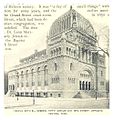Temple Beth-El (New York City)
| Temple Beth-El | |
|---|---|
 An illustration of the former synagogue, c. 1900s | |
| Religion | |
| Affiliation | Reform Judaism (former) |
| Ecclesiastical or organisational status | Synagogue (1891–c. 1929) |
| Status | Closed; demolished |
| Location | |
| Location | 945 Fifth Avenue and 76th Street, Upper East Side, Manhattan, New York City, New York |
| Country | United States |
Location of the former synagogue in Manhattan, New York City | |
| Geographic coordinates | 40°46′30″N 73°57′54″W / 40.775°N 73.965°W |
| Architecture | |
| Type | Synagogue |
| Style | Romanesque Revival |
| Date established | 1874 (as a congregation) |
| Completed | 1891 |
| Construction cost | $700,000 |
| Demolished | 1947 |
| Specifications | |
| Capacity | 2,190 worshippers |
| Length | 160 feet (49 m) |
| Width | 102 feet (31 m) |
| Height (max) | 1,200 feet (370 m) |
| Dome(s) | One |
| Dome height (outer) | 140 feet (43 m) |
| Dome dia. (outer) | 51 feet (16 m) |
| Materials | Indiana limestone, Mexican onyx, gold, Numidian marble, copper |
| [1] | |
Temple Beth-El was a Reform Jewish congregation and synagogue at 945 Fifth Avenue and 76th Street in the Upper East Side of Manhattan in New York City, New York, United States. The synagogue operated between 1891 until c. 1929, and was demolished in 1947. The Temple Beth-El congregation merged with Congregation Emanu-El of New York in 1927.
History
[edit]The congregation was formed on March 27, 1874, through the merger of Congregation Anshe Chesed with Temple Adath Jeshurun.[1] David Einhorn served as the congregation's first rabbi.[2] Kaufmann Kohler succeeded his father-in-law Einhorn as rabbi in 1879, serving there until he became president of Hebrew Union College in 1903.[3] Rudolph Grossman was associate rabbi of Temple Beth-El from 1889 to 1896.[4] Samuel Schulman was elected associate rabbi in 1901, and in 1903 he succeeded Kohler as rabbi.[5] He continued to serve as its rabbi until its merger in 1927.[6]
The Romanesque Revival building with Byzantine and Moorish influences, designed by Brunner & Tryon, was dedicated on September 18, 1891.[1][7] Completed with Indiana limestone, and interior fittings using Mexican onyx, gold, Numidian marble, and a copper-domed roof, the land and building costs amounted to $700,000 in 1891 ($23.7 million in 2023).[1] The large 51-foot (16 m) dome was reportedly modelled on the New Synagogue in Berlin.[8]
An organ by Odell Company was installed in the synagogue in 1890; and it was replaced by a new organ by M. P. Möller, installed in 1924 at the front of the synagogue above the bimah, obscured from public view.[9]
In 1927 the Temple Beth-El congregation merged with Congregation Emanu-El.[10][11] The congregation had barely used the synagogue since Yom Kippur in 1929, and was subsequently demolished in 1947.[1]
Gallery
[edit]References
[edit]- ^ a b c d e Miller, Tom (May 31, 2021). "The Lost Temple Beth-El - Fifth Avenue and 76th Street". Daytonian in Manhattan. Tom Miller. Retrieved December 30, 2023.
- ^ "New Temple Emanu-El Is Ready for Service". The New York Times. September 29, 1929.
- ^ Adler, Cyrus. "KOHLER, KAUFMANN". The Jewish Encyclopedia. Retrieved July 7, 2022.
- ^ Adler, Cyrus. "Grossman, Rudolph". The Jewish Encyclopedia. Retrieved March 10, 2022.
- ^ Adler, Cyrus; Haneman, Frederick T. "SCHULMAN, SAMUEL". The Jewish Encyclopedia. Retrieved July 7, 2022.
- ^ "Schulman, Samuel". Encyclopedia.com. Retrieved July 7, 2022.
- ^ "Their Temple Dedicated". The New York Times. September 19, 1891. p. 8.
- ^ Gruber, Samuel (April 16, 2015). "A Look at the High Facade Dome in Synagogue Architecture". Samuel Gruber's Jewish Art & Monuments. Samuel Gruber. Retrieved December 30, 2023.
- ^ "Congregation Beth-El". New York Organ List. The New York City Chapter of the American Guild of Organists. n.d. Retrieved December 30, 2023.
- ^ "Historic Temple Being Demolished" (PDF). The New York Times. April 29, 1947.
- ^ "Then and Now: Beth-El". New York Daily News. February 22, 1998.
- 1874 establishments in New York (state)
- 1927 disestablishments in New York (state)
- 19th-century synagogues in the United States
- Buildings and structures demolished in 1947
- Demolished buildings and structures in Manhattan
- Fifth Avenue
- Former synagogues in New York (state)
- Jewish organizations established in 1874
- Romanesque Revival architecture in New York City
- Romanesque Revival synagogues
- Synagogues completed in 1891
- Upper East Side
- Synagogue buildings with domes



